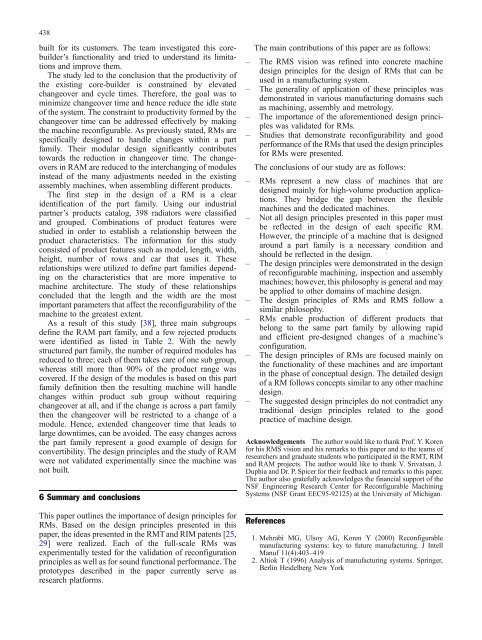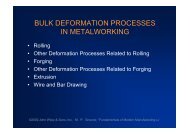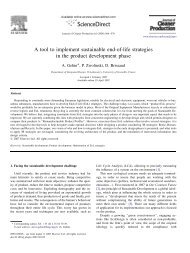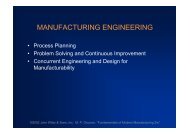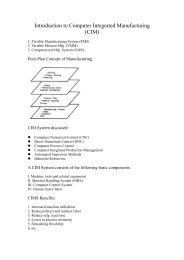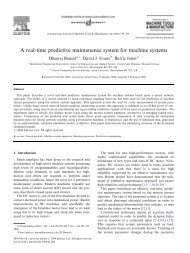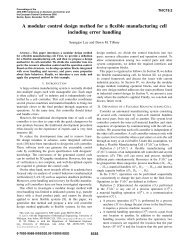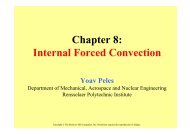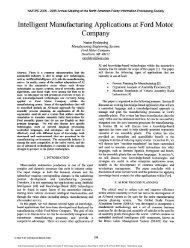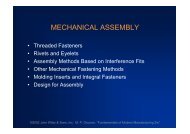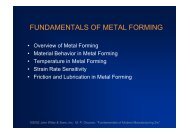Design principles of reconfigurable machines
Design principles of reconfigurable machines
Design principles of reconfigurable machines
Create successful ePaper yourself
Turn your PDF publications into a flip-book with our unique Google optimized e-Paper software.
438built for its customers. The team investigated this corebuilder’sfunctionality and tried to understand its limitationsand improve them.The study led to the conclusion that the productivity <strong>of</strong>the existing core-builder is constrained by elevatedchangeover and cycle times. Therefore, the goal was tominimize changeover time and hence reduce the idle state<strong>of</strong> the system. The constraint to productivity formed by thechangeover time can be addressed effectively by makingthe machine <strong>reconfigurable</strong>. As previously stated, RMs arespecifically designed to handle changes within a partfamily. Their modular design significantly contributestowards the reduction in changeover time. The changeoversin RAM are reduced to the interchanging <strong>of</strong> modulesinstead <strong>of</strong> the many adjustments needed in the existingassembly <strong>machines</strong>, when assembling different products.The first step in the design <strong>of</strong> a RM is a clearidentification <strong>of</strong> the part family. Using our industrialpartner’s products catalog, 398 radiators were classifiedand grouped. Combinations <strong>of</strong> product features werestudied in order to establish a relationship between theproduct characteristics. The information for this studyconsisted <strong>of</strong> product features such as model, length, width,height, number <strong>of</strong> rows and car that uses it. Theserelationships were utilized to define part families dependingon the characteristics that are more imperative tomachine architecture. The study <strong>of</strong> these relationshipsconcluded that the length and the width are the mostimportant parameters that affect the reconfigurability <strong>of</strong> themachine to the greatest extent.As a result <strong>of</strong> this study [38], three main subgroupsdefine the RAM part family, and a few rejected productswere identified as listed in Table 2. With the newlystructured part family, the number <strong>of</strong> required modules hasreduced to three; each <strong>of</strong> them takes care <strong>of</strong> one sub group,whereas still more than 90% <strong>of</strong> the product range wascovered. If the design <strong>of</strong> the modules is based on this partfamily definition then the resulting machine will handlechanges within product sub group without requiringchangeover at all, and if the change is across a part familythen the changeover will be restricted to a change <strong>of</strong> amodule. Hence, extended changeover time that leads tolarge downtimes, can be avoided. The easy changes acrossthe part family represent a good example <strong>of</strong> design forconvertibility. The design <strong>principles</strong> and the study <strong>of</strong> RAMwere not validated experimentally since the machine wasnot built.6 Summary and conclusionsThis paper outlines the importance <strong>of</strong> design <strong>principles</strong> forRMs. Based on the design <strong>principles</strong> presented in thispaper, the ideas presented in the RMT and RIM patents [25,29] were realized. Each <strong>of</strong> the full-scale RMs wasexperimentally tested for the validation <strong>of</strong> reconfiguration<strong>principles</strong> as well as for sound functional performance. Theprototypes described in the paper currently serve asresearch platforms.The main contributions <strong>of</strong> this paper are as follows:– The RMS vision was refined into concrete machinedesign <strong>principles</strong> for the design <strong>of</strong> RMs that can beused in a manufacturing system.– The generality <strong>of</strong> application <strong>of</strong> these <strong>principles</strong> wasdemonstrated in various manufacturing domains suchas machining, assembly and metrology.– The importance <strong>of</strong> the aforementioned design <strong>principles</strong>was validated for RMs.– Studies that demonstrate reconfigurability and goodperformance <strong>of</strong> the RMs that used the design <strong>principles</strong>for RMs were presented.The conclusions <strong>of</strong> our study are as follows:– RMs represent a new class <strong>of</strong> <strong>machines</strong> that aredesigned mainly for high-volume production applications.They bridge the gap between the flexible<strong>machines</strong> and the dedicated <strong>machines</strong>.– Not all design <strong>principles</strong> presented in this paper mustbe reflected in the design <strong>of</strong> each specific RM.However, the principle <strong>of</strong> a machine that is designedaround a part family is a necessary condition andshould be reflected in the design.– The design <strong>principles</strong> were demonstrated in the design<strong>of</strong> <strong>reconfigurable</strong> machining, inspection and assembly<strong>machines</strong>; however, this philosophy is general and maybe applied to other domains <strong>of</strong> machine design.– The design <strong>principles</strong> <strong>of</strong> RMs and RMS follow asimilar philosophy.– RMs enable production <strong>of</strong> different products thatbelong to the same part family by allowing rapidand efficient pre-designed changes <strong>of</strong> a machine’sconfiguration.– The design <strong>principles</strong> <strong>of</strong> RMs are focused mainly onthe functionality <strong>of</strong> these <strong>machines</strong> and are importantin the phase <strong>of</strong> conceptual design. The detailed design<strong>of</strong> a RM follows concepts similar to any other machinedesign.– The suggested design <strong>principles</strong> do not contradict anytraditional design <strong>principles</strong> related to the goodpractice <strong>of</strong> machine design.Acknowledgements The author would like to thank Pr<strong>of</strong>. Y. Korenfor his RMS vision and his remarks to this paper and to the teams <strong>of</strong>researchers and graduate students who participated in the RMT, RIMand RAM projects. The author would like to thank V. Srivatsan, J.Duphia and Dr. P. Spicer for their feedback and remarks to this paper.The author also gratefully acknowledges the financial support <strong>of</strong> theNSF Engineering Research Center for Reconfigurable MachiningSystems (NSF Grant EEC95-92125) at the University <strong>of</strong> Michigan.References1. Mehrabi MG, Ulsoy AG, Koren Y (2000) Reconfigurablemanufacturing systems: key to future manufacturing. J IntellManuf 11(4):403–4192. Altiok T (1996) Analysis <strong>of</strong> manufacturing systems. Springer,Berlin Heidelberg New York


